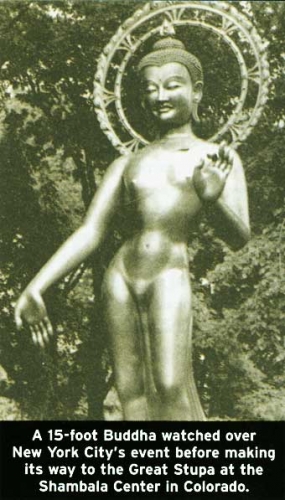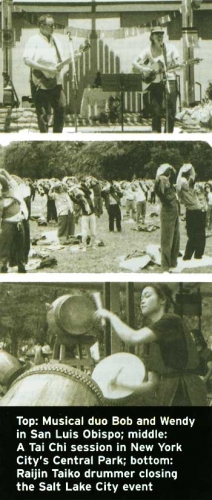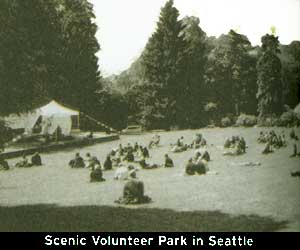At the first Change Your Mind Day in 1994, a few hundred people gathered in New York City’s Central Park for a day of free meditation instruction. Since then, participation in the event has spread to over twenty cities in the U.S. and Canada, and next year forty cities are expected to host events.
Change Your Mind Day 2001 was marked by tumultuous weather across the country. From the rain showers that threatened New York’s event to the intimacy of Brattleboro’s refuge in a fifteen-person yoga studio, Nature offered unexpected opportunities for deepening awareness. In different locations, meditation teachings were complemented by taiko drumming and martial arts demonstrations, mindful dancing, music and poetry readings.
If you are interested in starting a Change Your Mind Day in your area, please contact CYMD coordinator Rande Brown at Tricycle: cym@tricycle.com.
Following are reports from several of the CYMD sites this year.
CYMD in the East

Grim forecasts of heavy rain did not deter National CYMD Coordinator Rande Brown from pushing forward with New York City’s eighth annual day of public meditation in Central Park.
“I had a call in to a shaman and knocked myself out chanting mantras,” says Brown with a giggle. “I wasn’t willing to throw in the towel.”
Equally optimistic were Acharya David Schneider and Shambhala community volunteers, who graced the event with a monumental 15-foot-high, 2,400-pound standing bronze Buddha, which made its first public appearance before making its way across the continent to the Great Stupa of Dharmakaya at the Rocky Mountain Shambhala Center in Colorado. Raised by a small crane from the back of a flatbed truck, the statue hovered above its pedestal before making a gentle landing.
As if on cue, the rain let up as the ceremonial gong rang out 108 times to open the event. Tibetan musicians Dhondup Namgyal Khorko and Sherab Tsangpo sounded long horns. Lama Surya Das led everyone in chanting mantras, and Maggie Newman exhorted us all to get up and move our bones, T’ai Chi-style. Sharon Salzberg, Master Sheng-yen, Linda Jiko Cutts, Thubten Rinpoche, Loch Kelly, and Rev. T. K. Nakagaki led meditations.
New to the event this year was the Japanese Taiko Drum troupe Soh Daiko. Affiliated with the New York Buddhist Church, the troupe proved that, sometimes, mindful practice does not mean quiet sitting. Haiku poet Clark Strand, ably assisted by Tricycle staffer Christine Dzialo, led the children’s circle, with the kiddies composing lines like junior Bashos.
As the gong rang to close the event, the skies opened up once again. “It was an extraordinary day,” says Alexis Rubenstein, assistant coordinator of the event. “We were lucky enough to take advantage of a five-hour window between two fronts.”
The goal for the first CYMD in Brattleboro was to connect attendees with local Vermont teachers and meditation groups. “Since this was our first year, we did not want to overwhelm ourselves with a big crowd coming to see a well-known teacher,” Cheryl Wilfong stated. Due to rainy weather, the event was moved to a local yoga center that normally accommodates about fifteen students. The limitations of space therefore made mindful movement meditations and a Zen walk all the more challenging for the sixty participants. Also memorable was Karen Blanchard’s meditation on listening to sounds, including those of a nearby children’s birthday party. Wilfong remarked that, in the end, the day “certainly increased the feeling of spiritual companionship as well as the communication among the many local sitting groups in our area.”
In Pennsylvania, a special feature of Harrisburg’s CYMD was an “East Meets West” art exhibit held at a nearby gallery, curated by Virginia Cohn Parkum. Martial arts were a large part of Harrisburg’s event, and included a dynamic presentation of the art of the sword by the Itten Dojo, as well as a speech on Buddhism and the martial arts by Jose Johnson, former U.S.A. Taiji Team member and national champion, which concluded in a flowing demonstration of wushu and Qigong. Other highlights were a musical set from Blue Buddha Records, Buddhist children’s stories, and a poetry reading.
CYMD in the West

Despite the effort it took to keep the stage canopy from flying away in the wind, the third San Francisco CYMD was marked by a graceful mixture of lighthearted and sobering talks and practices. After discussing his path from troubled adolescent to dharma teacher for teenagers and prisoners, Noah Levine’s metta meditation was particularly poignant. Equally heartfelt was Marlene Jones Schoonover’s speech on her efforts to heal issues of color discrimination in her sangha. Wes Nisker’s lively presentation brought poetry, humor, and Buddhism together into the memorable message that “everything is everything is everything is everything.” Pearl Ubungen led a movement meditation that inspired one woman to begin a nude dance, giving audience members a chance to deepen their practice as they worked through their reactions. Program organizer and filmmaker Vivi Letsou remarked, “It was a rare gift to experience all these teachings in one day, and to realize that each speaker was instructing us to do essentially the same thing: to be present in this moment.”
In San Luis Obispo, CYMD speakers included Jason Siff, cofounder of the Skillful Meditation Project, who gave a talk on meditation in the Theravada tradition; Zen teacher Joe Bobrow, who asked the audience to explore the idea of dependent co-arising; and Monlam Vilbhuer, representing the Tibetan Buddhist tradition, who discussed the Four Noble Truths.
At CYMD in Seattle, the teachings had a deceptively simple air: the four teachers—two Theravadin, one Zen, one Tibetan—all discussed how practice can help us distinguish between illusion and reality. One especially powerful moment came as Ajahn Sona, a Canadian-born Theravadin monk, asked the audience, “How do we approach change? We do it mindfully,” and a gust of wind blew over and broke a flower-filled vase on the stage. Another Western Theravadin monk, Rev. Adhisila, didn’t say anything to the crowd—he was at the center of a small group of children, all happily playing with his new board game, “The Path,” a role-playing game that helps teach about the Eightfold Path, the Ten Perfections, and karma.
Approximately two hundred people changed their minds beneath the idyllic backdrop of the Wasatch mountains in Salt Lake City. Movement meditations were directed by masters of Wai-Dong-Kong and T’ai Chi, concluding in a stunning display of Japanese Raijin Taiko drumming. One participant commented that it was a “wonderful day for heart and mind.” More than one hundred attendees made this year’s CYMD inAnchorage the largest yet. Alaskan CYMD organizer Jishin Diane Van Parijs remarked, “Three years ago my biggest challenge was to persuade the various Buddhist groups within Anchorage to participate.
This event has become a catalyst for increased sharing in the dharma among the local sanghas and outreach to the general public.” New this year were monks from Wats Yanna Vararam and Dhamma Bhavana Buddhist Center, and members of IASC/Taoism Center for Wellness. Attendees brought picnics, flew kites, and constructed prayer flags.
CYMD in the Middle

The Clear Mind Sangha of Tam Quang Temple in Bradley, Michigan might possibly have been the smallest group to participate in CYMD. Still, twenty-five devoted participants showed up for a sitting and walking meditation led by the abbot of Tam Quang, Huyen Te, and an inspiring dharma talk on diversity within Western Buddhist practice delivered by Sathrindriya Perindeniye of the Great Lakes Buddhist Vihara.
In Wisconsin, Eau Claire was pleased to welcome visiting teacher Vidyuddeva from Dharma Field Zen Center in Minneapolis, and Dr. Rita Gross from the Minneapolis Shambhala Center, author of Buddhism After Patriarchy (SUNY Press, 1993). Vidyuddeva braided dharma talk and meditation instruction in an inspiring presentation on meditation as awareness, stressing the importance of experience over belief. Dr. Gross taught sitting and walking meditation, ending with a discussion of meditation as a catalyst to kindness. Another highlight of the day was local community member Sandra Helpsmeet’s group dance based on the Heart Sutra.
At Kansas City’s CYMD, attendees listened to an impassioned treatise on the karmic implications of death by teenage practitioner Bart Click of Soka Gakkai International, as well as to Vern Barnet’s novel translation of the Heart Sutra ending as “Far out! Far out!” Janet Taylor informed the audience about the American Buddhist Center (ABC), which serves as a clearinghouse for information about Buddhist organizations in Kansas City.
Austin’s events included dharma talks, meditation instruction, and presentations by local sanghas. Steve Bosbach reported, “We are already planning to work on a concerted outreach to the ethnic Buddhist sanghas in the Austin area, hoping for a more universal participation in the years to come.” ▼